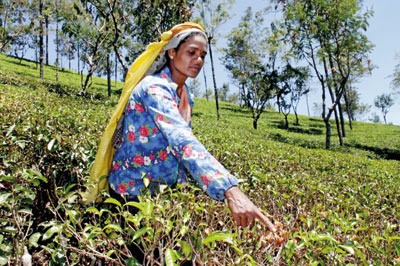Economic challenges highlighted, but policy directions unclear
Sri Lanka’s economic growth fell marginally to 4.8 per cent last year from 4.9 per cent in 2014 with the slowdown attributed to slowdown in the export sector and foreigners taking away their funds from Sri Lanka owing to a stronger US economy. This is according to the Central Bank’s annual report for 2015 released on Tuesday. “The impact of these developments was offset to some extent by lower international commodity prices,” the 2015 annual report said. Year-on-year headline inflation by end 2015 was recorded at 2.8 per cent, compared to 2.1 per cent at the end of 2014. Correspondingly, core inflation, which switches out energy and selected food items from the CCPI basket, grew from 0.8 per cent, on a year-on-year basis in February 2015, to reach 4.5 per cent at the end of the year.
This was driven primarily by the enhanced growth of bank credit as well as higher wages afforded to government workers and employees in other sectors of the economy, the report noted. “Meanwhile, despite substantial gains from the lower oil prices and continued positive trends in the tourism sector, slowing down of net foreign exchange inflows, including worker remittances, and capital outflows, generated an overall deficit in the balance of payments (BOP). Efforts to reverse the downward trend in government tax and non-tax revenues were moderately successful, but overruns on the expenditure side of the government budget meant that the budget deficit grew to 7.4 per cent of Gross Domestic Product (GDP), as against the targeted deficit of 4.4 per cent,” it said.

Tea crops were affected by the drought
Growth in real GDP in 2015 was largely driven by an increase in consumption demand, while investment activities made a modest contribution. Domestic savings declined to 22.6 per cent of GDP in 2015, from 24 per cent of GDP in 2014. This, together with the deterioration of net primary income from the rest of the world, along with a reduction in earnings on investment and increased outflows, dampened national savings in 2015, although remittances increased marginally, in rupee terms. “Accordingly, national savings declined to 27.8 per cent of GDP in 2015 from 29.5 per cent of GDP in the previous year,” it said. The unemployment rate increased to 4.6 per cent during 2015 compared to 4.3 per cent recorded in 2014, amidst a marginal increase in labour force participation, particularly by females.
The female unemployment rate increased from 6.5 per cent to 7.6 per cent, while the male unemployment rate declined from 3.1 per cent to 3.0 per cent in 2015, compared to 2014, it said. “Meanwhile, a sharp decline of 12.4 per cent was observed in the total number of departures for foreign employment, which could partly be attributed to escalated geo-political tensions and the slowdown of economic activity in the Middle East,” the report said adding that this had an impact on the unemployment rate as well as the labour force participation rate. “The performance of Sri Lanka’s external sector reflected the impact of the changing global economic environment as well as a number of developments in the domestic economy. In spite of the benefit of lower expenditure on fuel imports, the merchandise trade deficit widened marginally by 1.7 per cent over the previous year, due to the increase in non-oil imports and the slowdown in export earnings,” it said.
The rupee, which remained broadly stable during the first eight months of the year, depreciated at a faster pace from early September with the Central Bank’s decision to allow greater flexibility in the determination of the exchange rate, based on market forces. Accordingly, as of end 2015, the rupee had recorded a depreciation of 9.03 per cent against the US dollar. The deteriorating fiscal sector performance in 2015 resulted in deviations from the budgetary targets stipulated in the Interim Budget for 2015. The lower than expected collection of government revenue, high level of recurrent expenditure, particularly on salaries and wages, welfare expenditure, and higher than estimated outlay on interest payments, exerted a significant pressure on the overall budget deficit in 2015.


